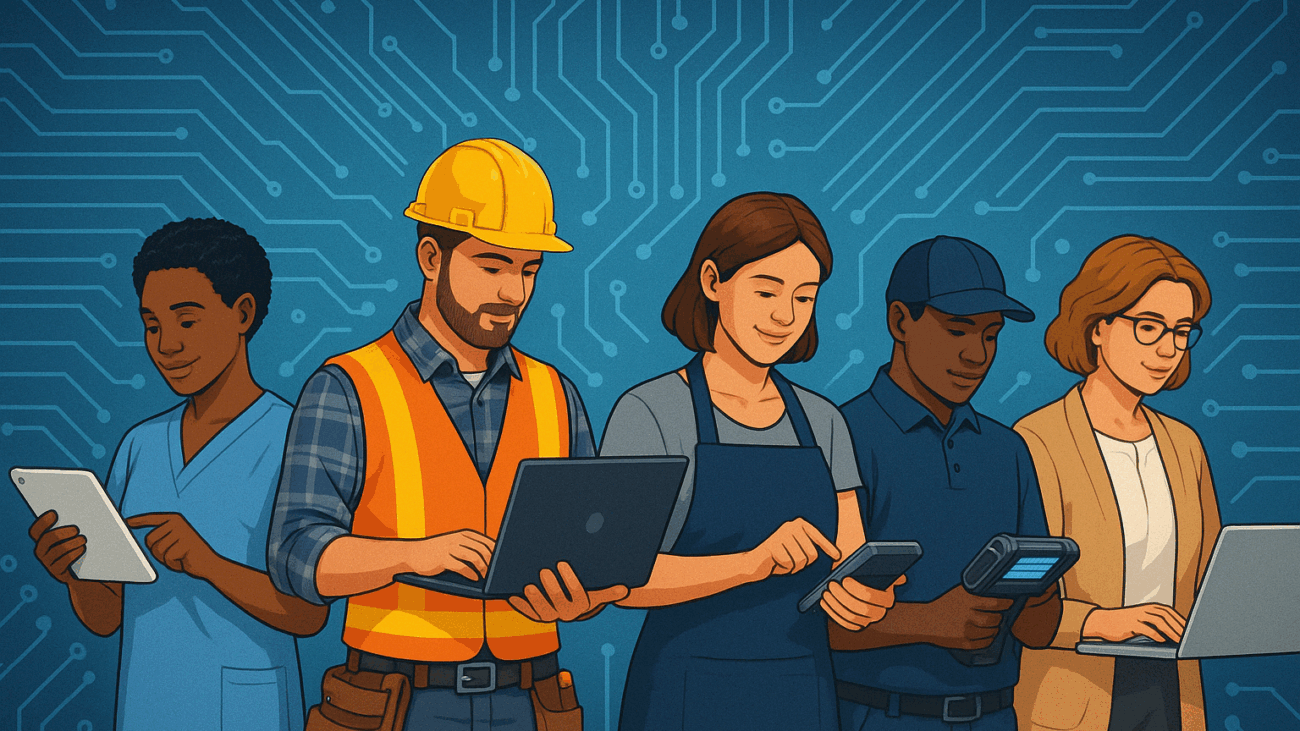There’s a quiet but decisive shift happening in today’s job market. Walk into any industry—healthcare, construction, retail, logistics, social work—and you’ll find digital skills not as a luxury or a bonus, but as a baseline.
Whereas only 44 percent of U.S. jobs required medium-high digital skill levels in 2002, 70 percent did by 2016 (Brookings Institution). According to the National Skills Coalition, today 92% of all job postings require some level of digital skill. This isn’t limited to tech jobs. It’s cashiers using point-of-sale systems, warehouse workers managing inventory with handhelds, or health aides inputting data on patient apps. Digital literacy isn’t a tech trend—it’s a workforce reality.
Digitalization is transforming the nation’s job roles both by expanding the digital content of hundreds of existing jobs and shifting the overall job mix toward more digitally intensive occupations.
Digital Skills = Higher Wages
“Workers with superior digital skills are more and more earning higher wages (all other things being equal) than similarly educated workers with fewer digital skills.”
—Digitalization and the American Workforce, pg 24
The data is clear. Workers qualified for jobs that require even one digital skill can earn an average of 23 percent more than in roles that require none. And making the jump to a job requiring at least three digital skills? That can lead to an average 45% increase in pay (National Skills Coalition).
In 2022, the World Bank piloted a market-aligned digital skills program designed to meet employer demand and build pathways to certification. Just three months after completion:
- Employment rates rose by 18%
- Participants’ average annual earnings increased by 94%
- The unemployment rate among graduates dropped by 18.5%
This kind of return—both personal and economic—is hard to ignore.
Certification Builds Trust—and Access
Knowing how to use digital tools is important. Being able to prove it is game-changing.
Digital credentials have emerged as a powerful way to demonstrate your readiness—no matter your academic background. In fact, according to the Brookings Institution, digital skills boost wages across all education levels, even when comparing workers with the same degree.
Certifications make those skills visible. They signal that you’ve taken initiative, invested in yourself, and understand the tools employers rely on. That’s why more and more hiring managers are looking beyond résumés and degrees to verify practical, up-to-date skills.
In a study published in the Journal of Public Economics, earning an online certification increased the likelihood of employment by 25%.
For jobseekers facing barriers—such as limited work history, justice involvement, or career transitions—certification is a trust builder. It helps level the playing field, offering a clear way to communicate your value and step into better opportunities.
You don’t need a four-year degree to move forward in today’s economy. You need skills—and a way to show them.
Final Word: Digital Skills Are No Longer Optional
We’re past the era where digital literacy was “nice to have.” Today, it’s a gateway—one that unlocks better jobs, higher wages, and a foundation for long-term growth. Whether you’re changing industries, re-entering the workforce, or supporting people navigating life transitions, digital skills aren’t just relevant—they’re essential.
You don’t need to know it all.
You just need to take the next step.
We’re all moving through a digital transformation—together. And taking even a few steps toward building your digital skills can have a massive impact on your job prospects, confidence, and experience in the labor market.
Where to Start: CTIC Can Help
The Carroll Technology and Innovation Council (CTIC) is here to walk with you as you build your digital confidence. We offer:
- Digital navigators who can guide you toward certifications that match your goals
- Free and low-cost classes, coaching, and learning materials
- Support exploring free online courses, from foundational computer use to more advanced tools
- Opportunities to discuss your goals with other learners and local employers so you can see where your skills fit
Whether you’re looking to start small or go big, CTIC is here to help you grow—on your terms.
Connect with a digital navigator, email train@carrolltechcouncil.org or call 443-244-1262


